Happy 2017!
- Design for the 2017 Boys Town Commemorative $5 Gold Coin Obverse
- 2017 Lions Clubs Commemorative Silver Dollar Proof Obverse
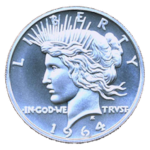 Last I reported, I had travelled to Philadelphia to see the students at Juaniata Park Academy that we raised money to visit the U.S. Mint and Federal Reserve. I did make it to the school despite the flat tire and other problems my Chevy Avalanche experienced along the way. We did have a one-hour visit to talk about coins, currency, and the history they reveal. I had a lot of fun. Rather than talk about it in this update, I will write a longer post soon.
Last I reported, I had travelled to Philadelphia to see the students at Juaniata Park Academy that we raised money to visit the U.S. Mint and Federal Reserve. I did make it to the school despite the flat tire and other problems my Chevy Avalanche experienced along the way. We did have a one-hour visit to talk about coins, currency, and the history they reveal. I had a lot of fun. Rather than talk about it in this update, I will write a longer post soon.
Counterfeiting is on the rise. The number of reported arrests for counterfeiters has increased. Some of it may be attributed to the largest seizure of counterfeit currency in Peru. Although not confirmed, there is speculation that the arrests in Peru provided leads into the distribution network. The Peru notes are amongst the best counterfeits produced outside of the United States. Unfortunately, there is no simple way to determine if you have one of these notes. The U.S. Secret Service has been advising cash-related businesses to be wary of people making unusual large cash purchases.
The U.S. Mint is preparing for an increase in sale of bullion American Eagle coins. Gold is down over $230 since its high in July or $151 since the election. Even with the strong dollar, the lower price of gold and the trust in the American Eagle coin is driving buyers to authorized dealers. One dealer said that 2017 pre-orders are their highest in a while.
The market for silver is facing a similar downward slide. From the $20.17 close in the beginning of August, the price as this is being written is $15.90. A 21-percent drop in silver spot prices is quite large over this period and greater than the 17-percent drop in the gold spot price.
Lower spot prices may be driving speculators to the market. Since the Federal Reserve Board increased the discount rate, the rate they charge for overnight loans to their large customers that are required to have a certain amount of liquidity at market close, by 250 basis points (.25 percent), there are some that believe that the markets are getting ready for a shift. Precious metals are always used as a hedge against inflation investments and may be a sign that some are expecting an economic crash.
A future post will discuss the coin-op industry’s reaction (albeit late reaction) to the GAO Report U.S. Coins: Implications of Changing Medal Compositions (GAO-16-177, Dec. 10, 2015). It appears to be an attempt for the coin-op industry to fight composition changes in U.S. coinage. Although most of their argument reads like a complaint that they do not want to undergo the cost of converting machines, they do make a point in that some of the alternatives has the potential to create a market for counterfeiting coins that would hurt the economy. One example they site is that it may be easier to counterfeit plated steel coins because the technology that checks for electromagnetic signatures of the coins would not be able to detect a real coin from a slug.
Following my post about the scrap industry not being able to return mutilated coins to the U.S. Mint I was contacted by someone in the industry who thanked me for the story. I was asked to emphasize that although the current court case involves companies based in China, the problems affect scrap dealers throughout the United States. Following this conversation, I was able to speak with a broker who has been buying scrap coins from smaller companies who said that the U.S. Mint has been discussing a way forward but in a way that makes it sound like they are not happy with having to deal with this situation. The U.S. Mint will not comment as long as there is an active case in federal courts.
The Apollo 11 50th Anniversary Commemorative Coin Act is now Public Law 114-282. Although I am not a collector of commemorative coins other than for topics that interest me, I am interested in this topic. Although I am a fan of silver coins, I am going to try to buy the gold Apollo 11 commemorative coin. I have two years to save my pennies!
Finally, I am working on creating a weekly newsletter opt-in containing numismatic-related stories from non-numismatic media sources from around the world. I will curate the news that appears in the newsletter but want to automate some of the processes. Automation of the workflow is in progress. Watch for the signup process to appear here soon!
Based on my posts from the last few weeks, I am sure you can tell I have a fascination with space. In fact, if there is such thing as reincarnation, I want to come back in the future to be able to travel around the universe in a manner similar to what we see in the movies. It is sad that there is no real enthusiasm for space exploration as there was when Apollo 11 landed on the moon!
In July 1969, my family lived in the Long Island suburbs of New York. The year before Apollo 11, my father bought a new, large RCA color television. Aside from learning that the beginning and end of Wizard of Oz was in black-and-white, I was able to watch the launches of the world’s largest Roman candle, the Saturn V rocket. Before Skylab and the Shuttle programs, it was a marvel of human achievement. I loved watching the liftoffs from Cape Kennedy and always wanted to go see one in person. I never did get to see a rocket launched, but I hope to some day.
This was a time when kids went outside to play, even in the summer evenings. We played a lot of baseball-related games including setting up a “field” in the street. Nobody was in the street. We were all home watching television and watching overhead shots of Mission Control in Houston. Even through the television, you could sense the tension until Neil Armstrong announced, “Houston, Tranquility Base here. TheEagle has landed.”
It wasn’t until years later when I learned more about the Cold War when I understood why it was more important for the United States to land and walk on the moon first. All I knew was it was very cool that an American was up there. It made Star Trek seem possible!
The moon walk was Monday night. Again, we were staring at the television watching the enactments as to what to expect. There were mockups of the Lunar Module and astronauts demonstrating what Armstrong was supposed to do. I remember the concentration on the “D-Ring,” the D-shaped handle that Armstrong had to pull on to open the door that had the camera. There was a question that the ring had to survive the landing and that the door could have jammed. We would have a historical moment without it being recorded on video!
“These are the first pictures ever broadcast from the moon,” was the words by whoever was on television. I remember the words but not who said them. Pulling on the D-ring worked and the world was watching. We watched as Neil Armstrong climbed down the ladder onto the surface of the moon. After a brief stop to remove the cover on the plaque that was attached to the ladder, Armstrong put both feet on the footpad of the lunar module. After a quick bounce step from the footpad to the surface of the moon, Armstrong gave his famous like, “That’s one small step for [a] man, one giant leap for mankind.”
There has been a “controversy” about whether Armstrong said “… one small step for man,” or “… one small step for a man.” Whatever is the correct version does not take away from the feat and the fact that Neil Armstrong was the first human being to set foot on Earth’s only natural satellite!
While NASA was the inspiration for many of the modern technologies we enjoy today, only Apollo 11 took it to the level of defining U.S. technology. While Skylab and the Shuttle programs were far more advanced, Apollo 11 stands as one of the 20th-century’s most amazing feats.
Needless to say, I am excited!
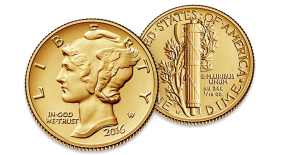 The U.S. Mint announced that they will sell off the remaining Mercury Dime 2016 Centennial Gold Coin starting at 12 Noon Eastern Time on Thursday, December 15, 2016. Although the website says the price is $200, it is likely that the opening price may be $205 based on the U.S. Mint Centennial Gold Price Grid and the average price of the London Gold Fix.
The U.S. Mint announced that they will sell off the remaining Mercury Dime 2016 Centennial Gold Coin starting at 12 Noon Eastern Time on Thursday, December 15, 2016. Although the website says the price is $200, it is likely that the opening price may be $205 based on the U.S. Mint Centennial Gold Price Grid and the average price of the London Gold Fix.
Order limit will be one per household.
Coins that will be on sale are coins that were left over when the sale was closed earlier this year, orders that were not completed for many reasons including credit cards that could not be processed, and a few returns that are not “spoiled.” If you order, you will not receive coins that were damaged and return.
There are only a few thousand left. Good luck!
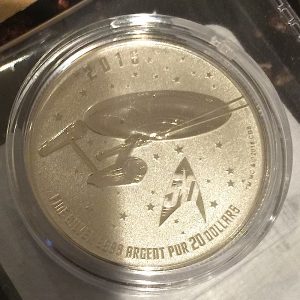 I admit to being fascinated by space and space travel. This has to go back to my watching the Mercury and Apollo missions as a youngster. Even then, I would watch most television shows that were based on space or something about space including the comedies Lost in Space and My Favorite Martian.
I admit to being fascinated by space and space travel. This has to go back to my watching the Mercury and Apollo missions as a youngster. Even then, I would watch most television shows that were based on space or something about space including the comedies Lost in Space and My Favorite Martian.
During its first run, I was able to watch Star Trek during its last season. When it was picked up in syndication and played on the independent television stations or late at night, I would watch and become a bigger fan. In college, it was common to walk into the TV Lounge to see the television tuned to Star Trek, especially late at night.
When Star Trek: The Motion Picture was released in 1979, I was able to see it during my December break from college. No, it wasn’t the best of the movies, but it was Star Trek. I was a fan of Star Trek: The Next Generation and I have seen all of the movies except the most recent—which I will catch when it is available on cable!
Aside from being great stories, Star Trek has inspired generations. Look at the technology that is in use today. Cell phones were inspired by the communicators; the ship’s computer with its infinite database processing is now in supercomputers of today, like IBM’s Watson; while Majel Barrett was the voice of the first computer, we now have Siri, Cortana and Alexa on portable devices; large flat screen displays are now our television; intelligent personal assistants went from the personal digital assistant (PDA) to being integrated with our computer that can now speak to us; then there is the universal translator; tablet computers; video conferencing; even something like Transparent Aluminum (Star Trek IV: The Voyage Home) exists in something called aluminum oxynitride (ALON). And remember, Scotty gave the formula for transparent aluminum using a quaint keyboard on a Macintosh!
Yes, I am a hard-core fan. But I have never been to a convention! I never really wanted to go. I did meet William Shatner when I was working for NBC, but that is another story for another time.
The Royal Canadian Mint has produced a set of coins for Star Trek fans. As part of the series, the Royal Canadian Mint produced three half-ounce silver coins with enameled images of Spock, Uhura, and Scotty; one ounce coins with images of iconic scenes: Captain Kirk in “Trouble with Tribbles,” the evil Spock and Dr. McCoy in “Mirror, Mirror,” and the time machines image that was in “The City on the Edge of Forever” which featured a guest appearance by Joan Collins. They are nice coins even though they are enameled. However, I think they are too expensive. It’s probably because of the licensing fees.
Of course, I had to get something. I decided to buy the $20 for $20 silver coin, Star Trek: Enterprise. It is a 7.96-gram silver coin with a face value of $20 with the reverse showing an image of the U.S.S. Enterprise and the Star Trek 50th Anniversary logo. The obverse has the portrait of Queen Elizabeth II, as required for all Canadian coins. While the RCM calls the finish “specimen,” it resembles a reverse proof. Not only is this $20 in Canadian funds, which is $15.22 in US funds as I type this, but there is also free shipping!
I also decided to buy was the stamp and coin set produced jointly with the RCM and Canada Post. The set includes a nickel-plated steel 25-cent coin with an engraved center surrounded by enamel ring with six different views of the U.S.S. Enterprise (NCC-1701). The stamp features Canadian-born actor William Shatner as Captain James T. Kirk with the U.S.S. Enterprise orbiting a red-colored planet in the background. Also included is a coil stamp produced as a collectible sheet featuring the U.S.S. Enterprise and a Klingon D7-class battle cruiser from the episode Day of the Dove.
You can buy the set from the RCM for $34.95 in Canadian funds, which is $26.60 in US dollars. If you buy the stamp and coin set separately, you will pay postage. However, if you buy both coins together, the RCM picks up the postage.
Before I forget, the Royal Canadian Mint will only ship directly to addresses in Canada and the United States. Collectors in other countries will have to contact a dealer.
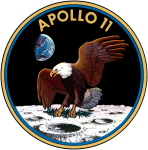 On Friday, December 9, during an early evening session under suspension of the rules, the Senate passed the Apollo 11 50th Anniversary Commemorative Coin Act (H.R. 2726). Since the bill was passed in the evening, it will be engrossed.
On Friday, December 9, during an early evening session under suspension of the rules, the Senate passed the Apollo 11 50th Anniversary Commemorative Coin Act (H.R. 2726). Since the bill was passed in the evening, it will be engrossed.
When a bill from congress is passed it is then engrossed. Engrossing a bill is the formal printing of the bill parchment or other paper of suitable quality, signed by the Speaker of the House and the designated presiding officer of the Senate (either the Vice President, President Pro-tempore, or the Majority Leader), and then sent to the White House for the President’s signature. When the president signs the engrossed bill, it then becomes law and given a Public Law number. The Public Law number is made up of the session congress, 114 as the 114th congress, and a sequence number.
I suspect that before the end of the week, the Apollo 11 50th Anniversary Commemorative Coin Act will be the law!
Apollo 11 has to be one of the top defining events of the 20th century. It captured the imagination of not only the United States but the world in a way nothing else could. Landing on the moon and having the Neil Armstrong, Buzz Aldrin, and Michael Collins safely return to earth using the technology of the day was a feat beyond imagination. And getting there before the blasted Soviets after they beat us into space for quite a number of years was also a big deal during the Cold War.
Now that the bill has passed, it is formally enrolled and signed by the Speaker of the House. It is sent to the Senate for their consideration. Hopefully, Majority Leader Mitch McConnell (R-KY) will put it on the schedule and get this passed without issue.
In case you forgot, here is what the bill requires for the Apollo 11 commemorative coins:
I am saving my pennies. I want a complete set!
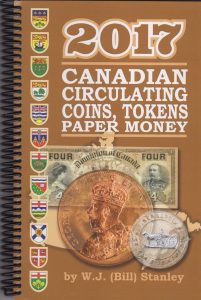 If you are a collector of Canadian coins and looking for a standard reference, there is nothing better than The Charlton Standard Catalogue of Canadian Coins. Available in two volumes, the Charlton catalogs would be the Canadian equivalent of the Red Book Professional Edition. Charlton Press also publishes books for the Canadian currency and token collectors. All of the Charlton books are very comprehensive on their respective topic and a must for the Canadian collector.
If you are a collector of Canadian coins and looking for a standard reference, there is nothing better than The Charlton Standard Catalogue of Canadian Coins. Available in two volumes, the Charlton catalogs would be the Canadian equivalent of the Red Book Professional Edition. Charlton Press also publishes books for the Canadian currency and token collectors. All of the Charlton books are very comprehensive on their respective topic and a must for the Canadian collector.
Like the Professional Edition of the Red Book, the Charlton Catalog is not a quick or portable reference. When I am searching through coins at shows or if I am just trying to identify something I had just acquired, I want a quicker reference with some basic prices that does not require me to hunt around the other information I am not interested in at the moment. I think I found the perfect reference for Canadian numismatics.
While searching one of my favorite online coin supply retailers, I came across the 2017 by W.J. (Bill) Stanley. It is published by Canadian Wholesale Supply of Paris, Ontario. Within the book, it does not carry a copyright date and it does not have an International Standard Book Number (ISBN). It can be found at a number of online numismatic stores but not on stores like Amazon that require an ISBN.
But if you are collecting Canadian Coins, Breton Tokens, or Canadian Paper money you should have a copy of this book sitting next to your Charlton Standard Catalog. While the Charlton books are very complete with a lot of information, the pictures are in black and white. All of the coin images in the Stanley book are in color. Although you can guess what the colors are, seeing the color images on varieties and being able to compare them with coins is of great help.
Another advantage of the Stanley book is that it consists only of circulating coinage. Although the Royal Canadian Mint has expanded its catalog of non-circulating legal tender coins over the last decade, if you are just collecting circulating issues, then the other stuff is clutter. It is just the basics of what was circulated in Canada.
This book is divided into three section. The first are circulating Canadian coins, the second for Canadian currency, and final are the tokens. The coin and currency section has a single introduction, guide to reading the tables, and an index to find the particular type you might try to find. The coin section has their pages numbered beginning with page 1 with the introductory parts numbered with Roman numerals. But the currency section begins on page B-1 following page 54 of the coins.
The tokens section appears as if it was a separate book bound with the coin and currency section to make one book. It has a title page followed by a similar introduction, guide to reading the information, and an index. The introductory pages are not numbered but the token listings begin on page T-1.
If the book was bigger, these page numbering anomalies would be confusing. I only noticed this when I tried to figure out how many pages are in the book. Considering that not every page is numbered and there are some blank pages in the middle, I think there are 132 pages in total. Not very thick and spiral bound for easier handling.
Prices in the book are given for the basic grades and includes prices for significant auctions and prices gathered for rare and significant coins. As most of us are aware, most printed price books are obsolete by the time they are published. What Stanley does is use information he gathers from auctions and coin shows around Canada to determine the prices. In his introduction, Stanley admits he uses his judgment to exclude what appears to be bogus data based on bidding wars or data from untrustworthy sources. He also admits that there may be errors.
Without reaching out to Stanley, it appears he is the sole responsible person for the prices and content of this guide. Maybe that is a good thing considering the inaccuracy of similar guides from other publishers. However, after go through his guide and a number of other sources including the prices from a few Canadian dealers, this book may be more accurate than his caveat suggests.
After that, it is pages of coin listings similar to any price guide you may find. The number of coins minted is included on each line. There are images of coins, images of varieties with an arrow point to subtle differences, and prices in the most relevant grades of circulating coins.
I cannot speak about the Charlton Standard Catalog of Canadian Currency since I do not own that book, but similar to the coins’ section, the Canadian currency section is nothing but the basics. Color images are reproduced from the Bank of Canada and have “SPECIMEN” superimposed on each note. Descriptions note signature, portrait, and serial number differences (i.e., prefix types) for the notes and the prices in the most relevant grades.
Tokens are a very important part of the history of Canadian money. When coins or currency was not available, Canadian towns and provinces created tokens to act in the place of money. The history of Canadian tokens is fascinating and worth another report. It is important to note that the cataloging of tokens is based on the work Pierre Napoleon Breton in his book Illustrated History of Coins and Tokens Related to Canada originally published in 1894, since republished and updated. As part of his cataloging of tokens, he assigned them a number that is now known as Breton Numbers. Stanley lists Canadian tokens by Breton Numbers.
Although I am not a collector of Breton Tokens, I am fascinated by other areas of numismatics especially if they are different. What thrills me about this section is that the tokens are imaged side-by-side with their basic information and prices. It is not a tome on their history but if I was a collector, it would help me identify these tokens and what I might expect to pay for them. I found myself flipping through the pages looking at the tokens, what they say, and thinking about their possible history. I want to go back through my back issues of The CN Journal (publication of the Royal Canadian Numismatic Association) and find some of those stories about tokens I never read.
Flipping the pages of such as basic reference, I never thought I would learn so much. I think it is because all of the other information has been omitted, I can see the coins, images of the varieties, and the prices without distraction. Now that I have learned a number of things, I can pick up other references to learn more.
My only minor nit about this book is the page numbering scheme and the lack of coherent index or table of contents. I give it a grade of MS-68 for being a simple reference of circulating Canadian numismatics and a book that I recommend.
The mutilated coin redemption industry is a multi-million dollar business. Most of the businesses involved with this industry are recyclers that find coins in cars and machines that are recycled. Recycling these metals require the use of heavy machinery that takes apart the items and compresses them to transport to processors. Six compressed cars can take up the same amount of space as one full-size car. More can fit in the same space if the metal is shredded.
Although some of the coins are removed from the cars, others end up in the machinery. After processing through high pressure and high heat, the found coins are in no condition to be sent to banks for redemption. Most of the time, these coins are cut, bent, or badly scorched making them impossible to process using normal coin counting mechanisms. According to an industry representative, recyclers can find an average of over $2 per car and over $10 in coin-operated machines as they are taken apart and crushed.
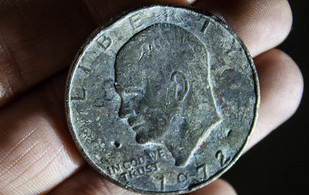 Coin-operated machines are not as well made as people suspect. For every time you might have had a coin “stuck” and lost in the machine, the coin might have dropped into an area outside of the coin bin and between internal parts. When the machines are serviced, the coins are usually dumped into bags and taken back to the company to be placed into coin counting machines. In many cases, the count between the expected amount of money and the number of items sold are not exact. This type of “shrinkage” is part of their business risk plans.
Coin-operated machines are not as well made as people suspect. For every time you might have had a coin “stuck” and lost in the machine, the coin might have dropped into an area outside of the coin bin and between internal parts. When the machines are serviced, the coins are usually dumped into bags and taken back to the company to be placed into coin counting machines. In many cases, the count between the expected amount of money and the number of items sold are not exact. This type of “shrinkage” is part of their business risk plans.
When the coin-operated machines are taken out of service, many are cleaned and inspected for loose coins. But the way the machines are designed, it is common that many coins are missed. They will continue to stay within the machine until it is discarded for scrap.
Cars and other machines sometimes gain a second life overseas. Machines are sold as surplus, repaired by their new owners and put into service around the world. These machines end up in the recycle system when they fall beyond the ability to be repaired. International recyclers recover U.S. coins from these cars and coin-operated machines. This is not including the scrap cars that are shipped overseas for recycling. Brokers buy the coins from recyclers and ship them to the United States. Currently, there is an estimated $1 million in mutilated coins being held by Customs and Border Patrol (CBP) while the redemption program is suspended. It is also estimated that more than $50 million in mutilated coins are being stored overseas while shipments are suspended.
As the mutilated coins accumulate, recyclers are now paying for storage and security over and above their regular business expenses. Some have sold their mutilated coins to other recyclers and brokers at a discount to avoid paying the storage costs. Those accumulating these mutilated coins are hedging on the mutilated coin-recycling program being restarted soon.
Brokers handling the import of these coins have filed suit against the CBP for blocking and holding the shipments of mutilated coins. Plaintiffs cite a report from a company called FormerFeds Group, a company made up of former federal lawyers and other senior officials, that said the accusation of importing mutilated coins from China is not true and that the amount of “junk” (non-coins in the batch) are within tolerances of the program. They are requesting that the court grants an order to release the coins and to compel the U.S. Mint to resume the Mutilated Coin Redemption Program.
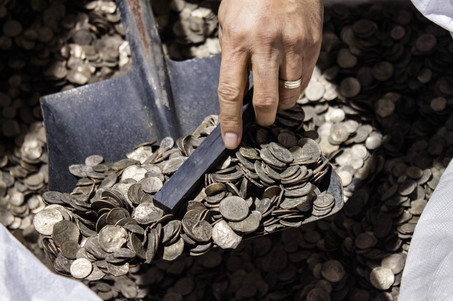
Hong Kong-based Wealthy Max Ltd. publicly opened and sampled 13 tonnes of mutilated U.S. coins waiting for shipment in Hong Kong. The coins come from piles of metal generated by automotive shredders and via incinerated waste streams.
Without fanfare, the U.S. Mint published a request in the Federal Register (81 FR 75922) asking for comments regarding the Mutilated Coin Exchange Program to supplement the information it has already gathered. The notice was published on November 1, 2016, without a follow up from the U.S. Mint press office. The U.S. Mint allowed for a two-week comment period that ended on November 15, 2016.
According to the Federal Register, the “Mint is considering include requiring participant certification, coinage material authentication, chain of custody information, and annual submission limitations.” They were seeking comment on that and other possible factors to better secure the program. There is no indication as to whether this is tied to the case brought by the brokers handling foreign recycling.
Coins make up a very small minority of the amount of scrap in the recycling stream. But with the problems caused by the U.S. Mint’s refusal to properly deal with this issue, it is taking up a lot of time and money both here in the United States and with long time business partners abroad.
While growing up in the New York City area, my mother felt that her children should go out and see the area which we lived. New York has a lot to see and do, but many do not visit the attractions even though many are a short subway ride away. Vacations were the same, whether it was to the Pennsylvania Dutch Country or Cooperstown, the destination was always something more than just seeing the sights.
After I started collecting coins, one of the trips was to the Chase Manhattan Bank Money Museum. Before the museum closed in 1974 and its assets were donated to the Smithsonian Institute for a tax deduction, the Money Museum was something for a wide-eyed pre-teen to see. I remember there was a Chinese Money Tree, a bronze tree structure with holed coins attached to its structure. Although I later learned it was a symbol of good luck, the image was important since my parents used to tell me, “Money doesn’t grow on trees.” Of course, the precocious child in me used the image to contradict that claim!
Museums tell the story of our history with props. With notable exceptions, numismatics are amongst the props used to tell the stories. Hollywood-themed museums have checks signed by the producers of major motion pictures and endorsed by actors. Political exhibits display the medals used to entice voters to vote for them. Colonial recreations use scrip that looks like paper money of the time to allow you to buy in their shops—Colonial Williamsburg used to do this many years ago.
To add to the stories, Princeton University reported that part of Princeton’s collection of ancient and medieval coins will be on permanent display at the Firestone Library on the Princeton campus. Princeton boasts a collection of over 110,000 pieces including coins, tokens, paper money, medals, and military decorations.In 2015, members of the Princeton University Art Museum Student Advisory Board (SAB) proposed that the library created the exhibit to supplement their education into ancient and medieval history. Constantin Weickart, a member of the SAB said, “I got interested in coins through courses in Late Antiquity, and basically all my professors used coins in their lectures. I saw how important coins are not only as objects but also as historical sources. Princeton has one the best coin collections in the world.”
SAB members Weickart, Daniel Elkind, and Hannah Baumann designed the exhibit including writing the labels that were associated with the coins and other images. They worked with Dr. Alan Stahl, the University curator of numismatics.
“[The coin collection] is there primarily for educational use. A lot of classes visit the coin collection during the course of the year,” Stahl said. “Students come to do research for term papers or get images of coins to use in presentations.”
Stahl added that the exhibit is also open to outside scholars for their research, especially since the coin collection will not be part of the rotating exhibit hall but part of the permanent display.
Although the collection is maintained for research, the Princeton Library is open to the public allowing anyone to visit the exhibit. Outside researchers can contact the library to gain access to their collection and some of the collection can be viewed online.